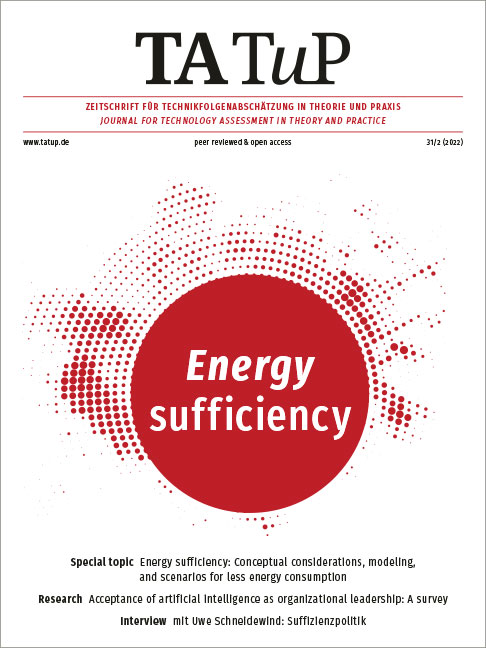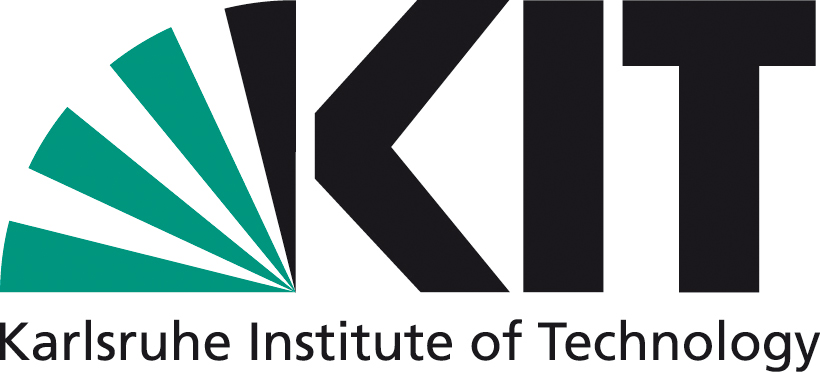Solar panels - is more always better?: Assessing the carbon footprint of communities
DOI:
https://doi.org/10.14512/tatup.31.2.25Keywords:
self-sufficiency, energy communities, energy sufficiency, optimal sizing, greenhouse gas emissionsAbstract
Are more solar panels always better in terms of carbon impact for a local energy community, and what is the influence of energy sufficiency? The answer is simple when the national electrical grid is taken as an infinite source of storage. However, this answer becomes uncertain if we consider that exporting power at the national scale is not a desired option. Although this is a conservative hypothesis, it is considered for technical and social reasons. In doing so, load profiles become a key to evaluating the carbon impact of hybrid systems with solar panels plus storage units. To summarize the impact of any load profiles on the optimal sizing of solar panels, we propose a novel index denoted ‘natural self-sufficiency’. Our results show that not only reducing energy demand but also being more flexible significantly affects the carbon emissions related to solar panels.
References
Bierwirth, Anja; Thomas, Stefan (2019): Energy sufficiency in buildings. European Council for an energy efficient economy concept papers. Wuppertal: Wuppertal Institute for Climate, Environment and Energy. Available online at https://www.energysufficiency.org/libraryresources/library/items/energy-sufficiency-in-buildings-concept-paper/, last accessed on 25. 05. 2022.
Brischke, Lars-Arvid; Lehmann, Franziska; Leuser, Leon; Thomas, Stefan (2015): Energy sufficiency in private households enabled by adequate appliances. In: Proceedings of the European Council for an energy efficient economy summer study, pp. 1571–1582. Available online at https://epub.wupperinst.org/frontdoor/deliver/index/docId/5932/file/5932_Brischke.pdf, last accessed on 16. 05. 2022.
Calero, Ivan; Canizares, Claudio A.; Bhattacharya, Kankar; Baldick, Ross (2022): Duck-Curve Mitigation in Power Grids With High Penetration of PV Generation. In: IEEE Transactions on Smart Grid 13 (1), pp. 314–329. DOI: https://doi.org/10.1109/TSG.2021.3122398
Delinchant, Benoit; Wurtz, Frédéric; Ploix, Stéphane; Schanen, Jean-Luc; Marechal, Yves (2016): GreEn-ER Living Lab. A green building with energy aware occupants. In: Proceedings of the 5th international conference on Smart Cities and green ICT systems, pp. 316–323. DOI: https://doi.org/10.5220/0005795303160323
Erba, Silvia; Pagliano, Lorenzo (2021): Combining sufficiency, efficiency and flexibility to achieve positive energy districts targets. In: Energies 14 (15), p. 4697. DOI: https://doi.org/10.3390/en14154697
Grubler, Arnulf et al. (2018): A low energy demand scenario for meeting the 1.5°C target and sustainable development goals without negative emission technologies. In: Nature Energy 3 (6), pp. 515–527. DOI: https://doi.org/10.1038/s41560-018-0172-6
Hodencq, Sacha; Coignard, Jonathan; Twum-Duah, Nana Kofi; Neves Mosquini, Lucas Hajiro (2022): Including greenhouse gas emissions and behavioural responses in the optimal design of PV self-sufficient energy communities. In: COMPEL – The international journal for computation and mathematics in electrical and electronic engineering. DOI: https://doi.org/10.1108/COMPEL-10-2021-0392
Huld, Thomas; Müller, Richard; Gambardella, Attilio (2012): A new solar radiation database for estimating PV performance in Europe and Africa. In: Solar Energy 86 (6), pp. 1803–1815. DOI: https://doi.org/10.1016/j.solener.2012.03.006
Illich, Ivan (1974): Energy and equity. London: Marion Boyars.
Luthander, Rasmus; Widén, Joakim; Nilsson, Daniel; Palm, Jenny (2015): Photovoltaic self-consumption in buildings. A review. In: Applied Energy 142, pp. 80–94. DOI: https://doi.org/10.1016/j.apenergy.2014.12.028
Peters, Jens; Baumann, Manuel; Zimmermann, Benedikt; Braun, Jessica; Weil, Marcel (2017): The environmental impact of Li-Ion batteries and the role of key parameters. A review. In: Renewable and Sustainable Energy Reviews 67, pp. 491–506. DOI: https://doi.org/10.1016/j.rser.2016.08.039
Quoilin, Sylvain; Kavvadias, Konstantinos; Mercier, Arnaud; Pappone, Irene; Zucker, Andreas (2016): Quantifying self-consumption linked to solar home battery systems. Statistical analysis and economic assessment. In: Applied Energy 182, pp. 58–67. DOI: https://doi.org/10.1016/j.apenergy.2016.08.077
Samadi, Sascha; Gröne, Marie-Christine; Schneidewind, Uwe; Luhmann, Hans-Jochen; Venjakob, Johannes; Best, Benjamin (2017): Sufficiency in energy scenario studies. Taking the potential benefits of lifestyle changes into account. In: Technological Forecasting and Social Change 124, pp. 126–134. DOI: https://doi.org/10.1016/j.techfore.2016.09.013
Zell-Ziegler, Carina et al. (2021): Enough? The role of sufficiency in European energy and climate plans. In: Energy Policy 157, p. 112483. DOI: https://doi.org/10.1016/j.enpol.2021.112483
Published
How to Cite
Issue
Section
License
Copyright (c) 2022 Jonathan Coignard, Sacha Hodencq, Nana Kofi Twum-Duah, Rémy Rigo-Mariani

This work is licensed under a Creative Commons Attribution 4.0 International License.








